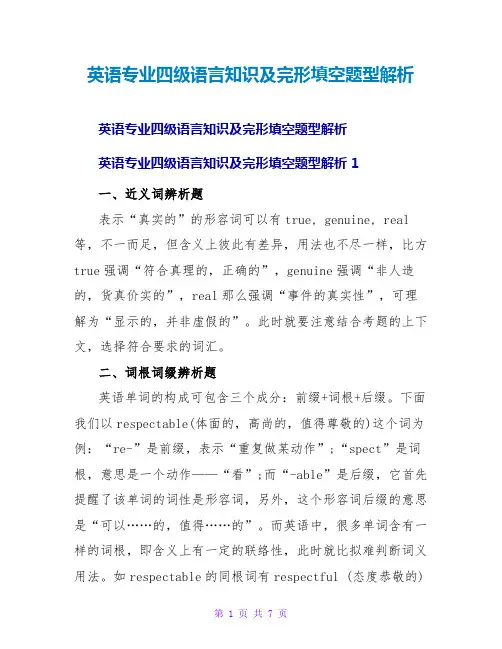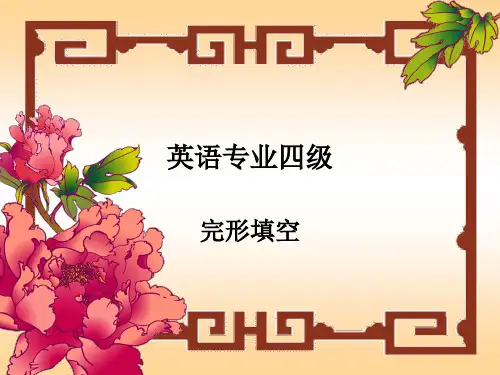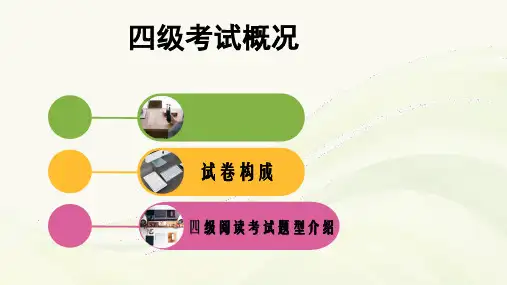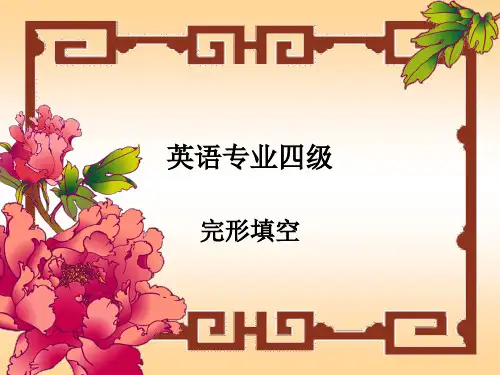全国专业四级英语填空题常考结构2
- 格式:doc
- 大小:42.00 KB
- 文档页数:8

英语专业四级语言知识及完形填空题型解析英语专业四级语言知识及完形填空题型解析英语专业四级语言知识及完形填空题型解析 1一、近义词辨析题表示“真实的”的形容词可以有true, genuine, real 等,不一而足,但含义上彼此有差异,用法也不尽一样,比方true强调“符合真理的,正确的”,genuine强调“非人造的,货真价实的”,real那么强调“事件的真实性”,可理解为“显示的,并非虚假的”。
此时就要注意结合考题的上下文,选择符合要求的词汇。
二、词根词缀辨析题英语单词的构成可包含三个成分:前缀+词根+后缀。
下面我们以respectable(体面的,高尚的,值得尊敬的)这个词为例:“re-”是前缀,表示“重复做某动作”;“spect”是词根,意思是一个动作——“看”;而“-able”是后缀,它首先提醒了该单词的词性是形容词,另外,这个形容词后缀的意思是“可以……的,值得……的”。
而英语中,很多单词含有一样的词根,即含义上有一定的联络性,此时就比拟难判断词义用法。
如respectable的同根词有respectful (态度恭敬的)和respective (各自的)。
这三个单词的词根都是“spect”,拼写也有些相似,但词义相去甚远。
平时复习时,考生应当重点积累这类含有一样词根的词汇,并且背单词时要学会掌握常见词根、前缀、后缀的含义,从而在解题时才可以运用构词法知识来判断词语含义。
三、动词词组题动词词组永远是考试的重点,尤其要注意同一个动词与不同介词组合,可结合成含义不同的词组,以动词give为例:“give out”表示“分发物品”;“give off”表示“散发出光辉或气味”;“give up”表示“放弃”;“give in”表示“屈从,投降,让步”。
考题中常给出一个动词,而后面用什么介词与之搭配,那么需要考生在选项中选词填空。
因此,考生在背单词时,需要专门花时间积累“动词+介词”词组。
四、从句引导词题英语的从句包括主语从句、表语从句、状语从句、定语从句、同位语从句、宾语从句等。


九、⽐较结构⽐较结构中要注意两点:1、倒装性;2、对称性 例1:Western Nebraska generally receives less snow than___eastern Nebraska. (A) does (B) in (C) it does in (D) in it does 分析:than引导⽐较状语从句,空格后⾯是个专有名词,肯定是⽐较从句的主语,空格处明显缺从句的谓语动词,只有(A)符合条件,故选(A)。
注意than eastern Nebraska does 是正确的语序,但是原⽂中使⽤了倒装;在⽐较结构的后⾯部分中,如果⽐较从句的主语长,谓语动词短,动词可放到主语前⾯进⾏到装。
例2: Hot objects emit___do cold objects. (A) rays more than infrared (B) rays are more infrared than (C) more than infrared rays (D) more infrared rays than 分析:emit为及物动词,空格处缺宾语和引导⽐较从句的than, 只有(D)符合条件。
注意空格后为倒装形式,do代替emit以避免重复。
此题为常考的句⼦结构。
⽐较结构中还需要注意相互⽐较的必须属于同⼀种事物例 例3:The activities of the international marketing researcher are frequently much broader than___. (A) the domestic marketer has (B) the domestic marketer does (C) those of the domestic marketer (D) that which has the domestic marketer 分析:本题还是考查⽐较句,由于谓语动词是系动词are, 故先排除与其不对应的以has和does结尾的(A)和(B)。




英语专业四级完形填空汇总练习题附答案 SANY标准化小组 #QS8QHH-HHGX8Q8-GNHHJ8-HHMHGN#一四级英语每日练习Passage 1It is well known that teenage boys tend to do better 1)______ math than girls, that male high school students are more likely than their female counterparts 2)______ advanced math courses like calculus, that virtually all the great mathematicians 3)______ men. Are women born with 4)______ mathematical ability Or does society's sexism slow their progress In 1980, two Johns Hopkins University researchers tried 5)______ theeternal nature/nurture debate. Julian Stanley and Camilla Benbow 6)______ 10,000 talented seventh and eighth graders between 1972 and 1979. Using the Scholastic Aptitude Test, in which math questions are meant to measure ability rather than knowledge, they discovered 7)______ sex differences. 8)______ the verbal abilities of the males and females 9)______ differed, twice as many boys as girls scored over 500 (on a scale of 200 to 800) on mathematical ability; at the 700 level, the ratio was 14 to 1. The conclusion: males have 10)______ superior mathematical reasoning ability. Benbow and Stanley's findings, 11)______ were published in "Science", disturbed some men and 12)______ women. Now there is comfort for those people in a new study from the University of Chicago that suggests math 13)______ not, after all, a natural male domain. Prof. Zalman Usiskin studied 1,366 tenth graders. They were selected from geometry classes andtested on their ability to solve geometry proofs, a subject requiring14)______ abstract reasoning and spatial ability. The conclusion 15)______ by Usiskin: there are no sex differences in math ability.1. A. at B. to C. of D. about2. A. in tackling B. tackling C. to tackle D. about tackling3. A. might be B. have been C. must be D. had been4. A. smaller B. less C. fewer D. not more5. A. to settle B. to set C. settling D. setting6. A. were tested B. have tested C. were testing D. had tested7. A. distinct B. instinct C. remote D. vague8. A. Since B. However C. As D. While9. A. scarcely not B. virtually C. largely D. hardly10. A. superficially B. universally C. inherently D. initially11. A. as B. that C. which D. all12. A. few B. not a few C. not few D. quite few13. A. be B. were C. was D. is14. A. none of B. neither of C. either D. both15. A. got B. gained C. reached D. accomplishedPassage 2We all know that a magician does not really depend on "magic" to perform his tricks, but on his ability to act at great speed. 16)______,this does not prevent us from enjoying watching a magician 17)______rabbits from a hat. 18)______ the greatest magician of all time was Harry Houdini who died in 1926. Houdini mastered the art of 19)______. He could free himself from the tight test knots or the most complicated locks in seconds.20)______ no one really knows how he did this, there is no doubt 21)______ he had made a close study of every type of lock ever invented. He liked to carry a small steel needle like tool strapped to his leg and he used this inplace of a key.Houdini once asked the Chicago police to lock him in prison. They22)______ him in chains and locked him up, but he freed himself 23)______ an instant. The police 24)______ him of having used a tool and locked him up again . This time he wore no clothes and there were chains round his neck, waist, wrists, and legs; but he again escaped in a few minutes. Houdini had probably hidden his "needle" in a wax like 25)______ and dropped it on the floor in the passage. 26)______ he went past, he stepped on it so that it stuck to the bottom of his foot. His most famous escape, however, was27)______ astonishing. He was heavily chained up and enclosed in an empty wooden chest, the lid of 28)______ was nailed down. The 29)______ was dropped into the sea in New York harbor. In one minute Houdini had swum to the surface. When the chest was 30)______, it was opened and the chains were found inside.16. A. Generally B. However C. Possibly D. Likewise17. A. to produce B. who produces C. produce D. how to produce18. A. Out of the question B. Though C. Probably D. Undoubted19. A. escaping B. locking C. opening D. dropping20. A. Surprisingly B. Obviously C. Perhaps D. Although21. A. if B. whether C. as to D. that22. A. involved B. closed C. connected D. bound23. A. at B. by C. in D. for24. A. rid B. charged C. accused D. deprived25. A. candle B. mud C. something D. substance26. A. As B. Usually C. Maybe D. Then27. A. overall B. all but C. no longer D. altogether28. A. it B. which C. that D. him29. A. chest B. body C. lid D. chain30. A. brought up B. sunk C. broken apart D. snapped二Passage 3Who won the World cup 1998 football game What happened at the United Nations How did the critics like the new play 31)______ an event takes place, newspapers are on the streets giving the details. Wherever anything happens in the world, reporters are on the spot to gather the news. Newspapers have one basic 32)______, to get the news as quickly as possible from its source, from those who make it to those who want to 33)______ it. Radio, telegraph, television, and 34)______ inventions brought competition for newspapers. So did the development of magazines and other means of communication. 35)______, this competition merely spurred the newspapers on. They quickly make use of the newer and faster means of communication to improve the 36)______ and thus the efficiency of their own operations. Today more newspapers are 37)______ and read than ever before. Competition also led newspapers to branch out into many other fields. Besides keeping readers 38)______ of the latest news, today's newspapers educate and influence readers about politics and other important and serious matters. Newspapers influence readers' economic choices 39)______ advertising. Most newspapers depend on advertising for their very 40)______. Newspapers are sold at a price that 41)______ even a small fraction of the cost of production. The main 42)______ of income for most newspapers is commercial advertising. The success in selling advertising depends on a newspaper's value to advertisers. This 43)______ in terms of circulation. How many people read the newspaper Circulation depends somewhat on the workof the circulation department and on the services or entertainment 44)______ in a newspaper's pages. But for the most part, circulation depends on a newspaper's value to readers as source of information 45)______ the community, city, country, state, nation and world and even outer space.31. A. Just when B. While C. Soon after D. Before32. A. reason B. cause C. problem D. purpose33. A. make B. publish C. know D. write34.A. anotherB. otherC. one anotherD. the other35.A. HoweverB. AndC. ThereforeD. So36.A. valueB. ratioC. rateD. speed37.A. spreadB. passedC. printedD. completed38.A. informB. be informedC. to be informedD. informed39.A. onB. throughC. withD. of40.A. formsB. existenceC. contentsD. purpose41.A. tries to coverB. manages to coverC. fails to coverD. succeeds in42.A. sourceB. originC. courseD. finance43.A. measuresB. measuredC. is measuredD. was measured44.A. offeringB. offeredC. which offeredD. to be offered45.A. byB. withC. atD. aboutPassage 4The United States is well known for its network of major highways designed to help a driver get from one place to another in the shortest possible time. 46)______ these wide modern roads are generally 47)______ and well maintained, with 48)______ sharp curves andstraight sections, a direct route is not always the most 49)______ one.Large highways often pass 50)______ scenic areas and interesting small towns. Furthermore, these highways generally 51)______ large urban centers, which means that they become crowded with 52)______ traffic during rush hours,53)______ the "fast, direct" route becomes a very slow route.However, there is almost always another routeto take 54)______ you are not in a hurry. Not far from the 55)______ new "superhighways", there are often older, 56)______ heavily traveled roads which go through the countryside. 57)______ of these are good two lane roads; others are uneven roads curving through the country. These secondary routes may go up steep slopes, along high 58)______, or down frightening hillsideto towns 59)______ in deep valleys. Through these less direct routes,longer and slower, they generally go to places 60)______the air is clean and scenery is beautiful, and the driver may have a chance to get a fresh, clean view of the world.46.A. AlthoughB. SinceC. BecauseD. Therefore47.A. stableB. splendidC. smoothD. complicated48.A. littleB. fewC. muchD. many49.A. terribleB. possibleC. enjoyableD. profitable50.A. toB. intoC. overD. by51.A. leadB. connectC. collectD. communicate52.A. largeB. fastC. highD. heavy53.A. whenB. forC. butD. that54.A. unlessB. ifC. asD. since55.A. relativelyB. regularlyC. respectivelyD. reasonably56.A. andB. lessC. moreD. or57.A. AllB. SeveralC. LotsD. Some58.B. cliffsC. roadsD. paths59.A. lyingB. layingC. laidD. lied60.A. thereB. whenC. whichD. wherePassage 5Early Tudor England was to a large extentself-sufficient. Practically all the necessities of life -- food, clothing, fuel and housing -- were produced from native resources by native effort, and it was to 61)______ these primary needs that the great mass of the population labored 62)______ its daily tasks. Production was for the most part organized in innumerable small units. In the country the farm, the hamlet and the village lived on 63)______ they could grow or make for themselves, and 64) ______ the sale of any surplus in the local market town, 65)______ in the towns craftsmen applied themselves to their one-man business, making the boots and shoes, the caps and the cloaks, the 66)______ and harness of townsmen and countrymen 67)______. Once a week town and country would meet to make 68)______ at a market which came 69) ______ realizing the medieval idea of direct contact between producer and 70)______. This was the traditional economy, which was hardly altered for some centuries, and which set the 71) ______ of work and the standard of life of perhaps nice out of 72) ______ ten English men and women. The work was long and 73)______, and the standard of life achieved was almost 74)______ low. Most Englishmen lied by a diet which was often 75)______ and always monotonous, wore coarse and ill-fitting clothes which harbored dirt undermine, and lived in holes whose squalor would affront the modern slum dweller.61.A. settleB. answerC. satisfy62.A. atB. inC. onD. with63.A. whichB. whatC. whetherD. where64.A. withB. byC. onD. for65.A. althoughB. whileC. neverthelessD. when66.A. machinesB. apparatusC. equipmentD. implement67.A. similarB. skinC. likeD. alike68.A. exchangeB. bargainC. dealingD. ride69.A. close atB. adjacent toC. near toD. near-by70.A. consumerB. buyerC. userD. shopper71.A. modelB. formC. patternD. method72.A. everyB. eachC. theD. other73.A. cruelB. hardC. ruthlessD. severe74.A. unimaginativelyB. unimaginablyC. imaginarilyD. unimaginedly75.A. weakB. littleC. meagerD. sparsePassage 6Unlike most sports, which evolved over time from street games, basketball was designed by one man to suit a particularpurpose. The man was Dr. James Naismith, and his purpose was to invent a vigorous game that could be played indoors in the winter.In 1891, Naismith was an instructor at a training school, which trained physical education instructors for the YMCAs. That year the school was trying 76)______ up with a physical activity that the men could enjoy 77)______ the football and baseball seasons. None of the standard indoor activities 78)______ their interest for long. Naismith was asked to solve the problem by the school.He first tried to 79)______ some of the popular outdoor sports, but they were all too rough. The men were getting bruised form tackling each other and 80)______ hit with equipment. So, Naismith decided to invent a game that would incorporate the most common elements of outdoor team sports without having the real physical contact.Most popular sports used a ball, so he chose a soccer ball because it was soft and large enough that it 81)______ no equipment, such as a bat or a racket to hit it. Next he decided 82)______ an elevated goal, so that scoring world depend on skill and accuracy rather than on 83)______ only.His goals were two peach baskets, 84)______ to ten-foot-high balconies at each end of the gym. The basic 85)______ of the game was to throw the ball into the basket. Naismith worth rules for the game, 86)______ of which, though with some small changes, are still87)______ effect.Basketball was an immediate success. The students 88)______ it to their friends and the new sport quickly 89)______ on. Today, basketball is one of the most popular games 90)______ the world.76.A. to have comeB. comingC. comeD. to come77.A. between? ? ? ?B. duringC. whenD. for78.A. rousedB. heldC. hadD. were79.A. imitateB. adoptC. adaptD. renovate80.A. beingB. to beC. beenD. were81.A. requestedB. usedC. requiredD. took82.A. onB. toC. ofD. with83.A. powerB. strengthC. forceD. might84.A. fixedB. fixingC. that fixD. which fixed85.A. methodB. ruleC. wayD. ideaB. muchC. manyD. little87.A. withB. in? ? ? ?C. onD. for88.A. definedB. spreadC. taughtD. discussed89.A. wentB. tookC. putD. caught90.A. ofB. throughoutC. amongD. through1. A2. C3. B4. B5. A6. D7. A8. D9. D10. C11. C12. B13. D16. B17. C18. C19. A20. D21. D22. D23. C24. C25. D26. A27. D28. B29. A30. A31. C32. D33. C34. B35. A36. D37. C38. D39. B40. B41. C42. A43. C44. B45. D46. A47. C48. B49. C50. D51. B52. D55. A56. B57. D58. B59. A60. D61. C62. A63. B64. C65. B66. D67. D68. A69. C70. A71. C72. A73. B74. B75. C76. D77. A78. B79. C80. A81. C82. A83. B84. A85. D86. C87. B88. C89. B90. B ClozeDecide which of the choices given below would correctly complete the passage if inserted in the corresponding blanks. Select the correct choice for each blank.Aesthetic thought of a distinctively modern bent emerged during the 18th century.? ? The western philosophers and critics of this time devoted much attention to such matters (1)_____ natural beauty, the sublime, and representation -- a trend reflecting the central position they had given to the philosophy of nature.? ? (2)_____ that time, however, the philosophy of art has become ever more (3)_____ and has begun to (4)_____ the philosophy of nature.? ? Various issues (5)_____ to the philosophy of art have had a (6)_____ impact (7)_____ the orientation of 20th-century aesthetics.? ?(8)_____ among these are problems relating to the theory of art as form and(9)_____ the distinction between representation and expression.? ? Still another far-reaching question has to do with the value of art.? ? Two opposing theoretical positions (10)_____ on this issue: one holds that art and its appreciation are a means to some recognized moral good, (11)_____ the other maintains that art is intrinsically valuable and is an end in itself.? ? Underlying this whole issue is the concept of taste, one of the basic concerns of aesthetics.? ? In recent years there has also been an increasing (12)_____ with art as the prime object of critical judgment.? ? Corresponding to the trend in contemporary aesthetic thought, (13)_____ have followed (14)_____ of two approaches.? ? In one, criticism is restricted to the analysis and interpretation of the work of art.? ? (15)_____, it is devoted to articulating the response to the aesthetic object and to(16)_____ a particular way of perceiving it.Over the years, aesthetics has developed into a broad field of knowledge and inquiry.? ? The concerns of contemporary aesthetics include such (17)_____ problems as the nature of style and its aesthetic significance; the relation of aesthetic judgment to culture; the (18)_____ of a history of art; the (19)_____ of Freudian psychology and other forms of psychological study to criticism; and the place of aesthetic judgment in practical (20)_____ in the conduct of everyday affairs.1.A. forB. asC. toD. with2.A. SinceB. ForC. AsD. In3.A. promotionalB. promissoryC. promiscuousD. prominent4.A. plantB. supplantC. transplantD. replant5.A. centralB. concentratingC. focusingD. centering6.A. markingB. remarkingC. markedD. remarked7.A. onB. forC. inD. to8.A. ForebodyingB. ForemostC. ForethoughtfulD. Foregone9.A. forB. forC. toD. on10.A. have broughtB. have been broughtC. have takenD. have been taken11.A. whereasB. whereinC. whereonD. wherefore12.A. preoccupancyB. preoccupationC. premonitionD. preoption13.A. artistsB. writersC. criticsD. analysts14.A. allB. eitherC. neitherD. none15.A. In the other mannerB. In the other wayC. In anotherD. In the other16.A. justifyB. justifiedC. justifyingD. having justified17.A. diverseB. dividedC. divineD. dividual18.A. vicinityB. viabilityC. villainyD. visibility19.A. relianceB. reliabilityC. reliefD. relevancy20.A. reasonB. reasonablenessC. reasoningD. reasonability1. B2. A3. D4. B5. A6. C7. A8. B9. C10. D11. A12. B13. C14. B15. D16. C17. A18. B19. D20. CClozeDecide which of the choices given below would correctly complete the passage if inserted in the corresponding blanks. Select the correct choice for each blank.Painting, the execution of forms and shapes on a surface by means of pigment, has been continuously practiced by humans for some 20,000 years.? ? Together with other activities (1)_____ ritualistic in origin but have come to be designated as artistic (such as music or dance), painting was one of the earliest ways in which man (2)_____ to express his own personality and his(3)_____ understanding of an existence beyond the material world.? ?(4)_____ music and dance, however, examples of early forms of painting have survived to the present day.? ? The modern eye can derive aesthetic as well as antiquarian satisfaction (5)_____ the 15,000-year-old cave murals of Lascaux -- some examples (6)_____ to the considerable powers ofdraftsmanship of these early artists.? ? And painting, like other arts, exhibits universal qualities that (7)_____ for viewers of all nations and civilizations to understand and appreciate.The major (8)_____ examples of early painting anywhere in the world arefound in Western Europe and the Soviet Union.? ? But some 5,000 years ago,the areas in which important paintings were executed (9)_____ to the eastern Mediterranean Sea and neighboring regions.? ? (10)_____, Western shared a European cultural tradition -- the Middle East and Mediterranean Basin and, later, the countries of the New World.? ?Western painting is in general distinguished by its concentration (11)_____ the representation of the human (12)_____, whether in the heroic context of antiquity or the religious context of the early Christian and medieval world.? ? The Renaissance (13)_____ this tradition through a (14)_____ examination of the natural world and an investigation of balance, harmony, and perspective in the visible world, linking painting (15)_____ the developing sciences of anatomy and optics.? ? The first real (16)_____ from figurative painting came with the growth of landscape painting in the 17th and 18th centuries.? ? The landscape and figurative traditions developed together in the 19th century in an atmosphere that was increasingly(17)_____ "painterly" qualities of the (18)_____ of light and color and the expressive qualities of paint handling.? ? In the 20th century theseinterests (19)_____ to the development of a third major tradition in Western painting, abstract painting, which sought to (20)_____ and express the true nature of paint and painting through action and form.1.A. may have beenB. that may haveC. may haveD. that may have been2.A. seekB. soughtC. seek forD. sought for3.A. emergingB. emergencyC. mergingD. merger4.A. AsB. UnlikeC. LikeD. Since5.A. fromB. toC. intoD. for6.A. ratifyB. testifyC. certifyD. gratify7.A. make easyB. make it easyC. make hardD. make it hard8.A. extinctB. extentC. extantD. exterior9.A. had shiftedB. have shiftedC. shiftingD. shifted10.A. NeverthelessB. MoreoverC. HoweverD. Therefore11.A. toB. inC. onD. for12.A. figureB. shapeC. shadowD. form13.A. extractedB. extendedC. extortedD. extruded14.A. closingB. closeC. closedD. closure15.A. onB. forC. inD. to16.A. breakB. breakageC. breakdownD. breaking17.A. concerned withB. concerningC. concerning withD. concerned for18.A. reactionB. actionC. interactionD. relation19.A. distributedB. attributedC. contributedD. construed20.A. discoverB. uncoverC. recoverD. cover2. B3. A4. B5. A6. B7. B8. C9. D10. D11. C12. A13. B14. B15. D16. A17. A18. C19. C20. BDirections: Decide which of the choices given below would correctly complete the passage if inserted in the corresponding blanks.? ? Select the correct choice for each blank.Flight simulator (飞行模拟器) refers to any electronic or mechanical system for training airplane and spacecraft pilots and crew member by simulating flight conditions.? ? The purpose of simulation is not to completely substitute (1)_____ actual flight training but to thoroughly familiarize students with the vehicle (2)_____ before they (3)_____ extensive and possibly dangerous actual flight training.? ? Simulations also is useful for review and for familiarizing pilots with new (4)_____ to existing craft. Two early flight simulators appeared in England within a decade after the first flight of Orville and Wilbur Wright.? ? They were designed to enable pilots to stimulate simple aircraft (5)_____ in three dimensions: nose up or down; left wing high and right low, or vice versa; and (6)_____ to left or right.? ? It took until 1929, however, for a truly effective simulator, the Link Trainer, to appear, devised by Edwin A. Link, a self-educated aviator and inventor from Binghamton, New York.? ? (7)_____, airplane instrumentation had been developed sufficiently to permit "blind" flying on instruments alone, but training pilots to do so involved (8)_____ risk.? ? Link built a model of an airplane cockpit equipped (9)_____ instrument panel and controls that could realistically stimulate all the movements of an airplane.? ? Pilots could use the device for instrument training, manipulating the controls (10)_____ instrument readings so as to maintain straight and level flight or (11)_____ climb or descent with no visual reference (12)_____ any horizon except for the artificial one on the instrument panel.? ? The trainer was modified (13)_____ aircraft technology advanced.? ? Commercial airlines began to use the Link Trainer for pilot training, and the US government began purchasing them in 1934, (14)_____ thousands more as World War II approached.Technological advances during the war, particularly in electronics, helped to make the flight simulator increasingly (15)_____.? ? The use of efficient analog computers in the early 1950s led to further improvements.? ? Airplane cockpits, controls, and instrument displays had by then become so individualized that it was no longer feasible to use a generalized trainer to prepare pilots to fly anything (16)_____ the simplest light planes.? ? By the 1950s, the US Air Force was using simulators that precisely (17)_____ the cockpits of its planes.? ? During the early 1960s (18)_____ digital and hybrid computers were adopted, and their speed and flexibilityrevolutionized simulation systems.? ? Further advances in computer and(19)_____ technology, notably the development of virtual-reality simulation, have made it possible to (20)_____ highly complex real-life conditions.1.A. forB. toC. withD. on2.A. concerningB. concernC. being concernedD. concerned3.A. undertakeB. undergoC. underplayD. underuse4.A. modelsB. modificationsC. modifiersD. modica5.A. manifestationsB. manipulationsC. manifestoesD. maneuvers6.A. yawlingB. yawningC. yawingD. yawping7.A. From then onB. From now onC. By nowD. By then8.A. considerableB. considerateC. consideringD. considered9.A. forB. inC. withD. on10.A. on the part ofB. on the basis ofC. on the track ofD. on the verge of11.A. controlB. controllableC. controlledD. controller12.A. toB. forC. onD. in13.A. as forB. as toC. asD. for14.A. acquiringB. requiringC. sustainingD. retaining15.A. actualB. realisticC. realizingD. true16.A. exceptB. except forC. apart fromD. but17.A. replenishedB. replacedC. replicatedD. reposed18.A. electronicB. electricC. electricityD. electron19.A. programB. programmableC. programmedD. programming20.A. resurrectB. reproduceC. resuscitateD. resume2. D3. B4. B5. D6. C7. D8. A9. C10. B11. C12. A13. C14. A15. B16. D17. C18. A19. D20. B。

度全国英语专业四级试题及答案(2)SECTION B CONVERSATIONIn this section, you will hear nine short conversations between two speakers. At the end of each conversation you will be given 10 seconds to answer the question.9.What are the speakers probably going to do?A. To persuade Mary to spend more time on her lessonsB. To help Mary to prepare for the upcoming concert.C. To talk with Mary about going to the concert.D. To ask Mary to stop worrying about the exam10. What can we learn about the man?A. He firmly believes in UFOs.B. He is doubtful about UFOs.C. He is sure many people have seen UFOs.D. He thinks many people have lied about UFOs.11. Which of the following has the man never been interested in?A. Electronic music.B. Civil engineering.C. Electronics.D. Electronic engineering.12. What does the man mean?A. The milk is safe to drink.B. The milk is not safe to drink.C. She shouldn’t have bought the milk.D. He wouldn’t have milk for breakfast.13. How many people were caught in the fire?A.6.B.5.C.4.D.7.14. What can we learn from the conversation?A. The woman will attend her course at 7:45.B. The woman will be late for the blood test.C. The woman will have her blood tested before the first class.D. The woman decides to miss the first class for her blood test.15. What is the probable relationship between the two speakers?A. Salesman and customer.B. Expert on jewelry and his wife.C. Estate agent and client.D. Husband and wife.16. How does the man probably feel?A. Nervous.B. Uninterested.C. ConfidentD. Upset.17. What do we know about Bill?A. He is thoughtful.B. He is forgetful.C. He is careless.D. He is helpful.SECTION C NEWS BROADCASTQuestions 18 and 19 are based on the following news .At the end of the news item, you will be given 20 seconds to answer the questions.Now listen to the news.18. Which of the following is NOT a condition for the reduction of debts?A. Poverty elimination.B. Good government.C. Fight against corruption.D. Poor living standard.19. By cancelling the debts owed to her, Britain intends to ___a similar scheme proposed by the International Monetary Fund.A. rejectB. restartC. followD. reviewQuestions 20 and 21 are based on the following news. At the end of the news item, you will be given 20 seconds to answer the questions.Now listen to the news.20. What happened during the accident?A. A train hit another train.B. A train killed 23 people.C. A train went off its tracks.D. A train was trapped inside the station.21. Which of the following statements best describes the condition of the passengers?A. No one was fatally injured.B. There were many heavy casualties.C. No one was hurt during the accident.D. Someone was killed during the accidentQuestions 22 and 23 are based on the following news. At the endof the news item, you will be given 20 seconds to answer the questions.Now listen to the news.22. The civil servants held a strike to protest___.A. spending cuts.B. reform measuresC. pay cuts.D. low pay.23. The civil servants’strike was staged___the general strike.A. a few days afterB. a few days beforeC. a few weeks afterD. a few weeks beforeQuestions 24 and 25 are based on the following news. At the end of the news item, you will be given 20 seconds to answer the questions.Now listen to the news.24. Which is the main idea of the news?A. Industrial relations in Germany.B. The German energy industry.C. Coalition in the government.D. Closure of nuclear reactors.25. The decision to shut down nuclear reactors resulted from the demand from___.A. the GovernmentB. the energy industryC. a party in the coalitionD. a declining need for nuclear energy三.完型填空Part Ⅳ CLOZE [15 MIN.]Decide which of the choices given below would best complete the passage if inserted in the corresponding blanks. Mark the best choice for each blank on your answer sheet.People thinking about the origin of language for the first time usually arrive at the conclusion that it developed gradually as a system of grunts, hisses and cries and ( 26 ) a very simple affair in the beginning.( 27 ), when we observe the language behaviour of ( 28 )we regard as primitive cultures,we find it ( 29 )complicated. It was believed that an Eskimo must have the tip of his tongue a vocabulary of more than 10,000 words ( 30 ) to get along reasonably well, much larger than the active vocabulary of an average businessman who speaks English.( 31 ), these Eskimo words are far more highly infleeted(词尾变化的) than ( 32 ) of any of the well -known European languages,for a( 33 )noun can be spoken or written in ( 34 ) hundred different forms, each ( 35 )a precise meaning different from that of any other.The forms of the verbs are even more( 36 ). The Eskimo language is, therefore,one of the most difficult in the world to learn,( 37 ) the result that almost no traders or explorers have( 38 )tried to learn it. Consequently , there has grown up, in communication between Eskimos and whites, a jargon ( 39 )to the pidgin English used in Old China, with avocabulary of from 300 to 600 uninflected words. Most of them are derived from Eskimo but some are derived from English, Danish,Spanish, Hawaiian and other languages. It is this jargon that is usually( 40 ) by travellers as “the Eskimo language”.26. A. must be B. must have beenC. ought to beD. should be27. A. However B. ThereforeC. ProbablyD. Undoubtedly28. A. whose B. thatC.whichD.what29. A. conspicuously B. usuallyC. surprisinglyD. sufficiently30. A.so as B.so thatC. as suchD. as well as31. A. However B. MoreoverC. ThoughD. Therefore32. A. the others B. all othersC. theseD. those33. A. single B. singularC. pluralD. compound34. A. some B. severalC. variousD. varied35. A. getting B. causingC. havingD. owning36. A. endless B. multipleC. uncountableD. numerous37. A. with B.forC. owing toD.as38. A. still B. indeedC. justD. even39. A. alike B. similarC. relatedD. relevant40. A. referred to B. talked aboutC. spokenD. told。

CET4——选词填空选词填空的考察形式:一篇280词左右的文章,文章中挖出10个空,并统一给出A-O15个备选答案。
一.词性归类:名词、动词、形容词、副词归类区分注意要点:(1)部分词汇有名词和做动词两个词性,比如 display, concern, challenge. 两个词性都应标出,再结合文章取舍(2)动词还要两分,那就是谓语和非谓语动词。
所谓非谓语动词,就是-ing, -ed, to do型的,其它的都是谓语动词。
以ing, ed 结尾的词既可能是动词,也可能是分词转变而来的形容词Holding 做动词:She’s holding her mother’s hand.做形容词:holding company (控股公司);二.四级常用后缀1. 名词后缀1)-or/er/ess/crat/cis:做某件事情或职业的人或物:worker,debtor2)-acy, 表示"性质,状态,境遇" democracy, accuracy,diplomacy3)-ance, -ence 表示"性质,状况,行为,过程,总量,程度”importance, diligence, difference, obedience4)-ancy, -ency, 表示"性质,状态,行为,过程" frequency, urgency, efficiency, 、5)-bility, 表示"动作,性质,状态" possibility, flexibility, feasibility,6)-dom, 表示"等级,领域,状态" freedom, kingdom, wisdom7)-hood, 表示"资格,身份, 年纪,状态" childhood, manhood, falsehood8)-ion, -sion, -tion, -ation, -ition, 表示"行为的过程,结果,状况" action, solution, conclusion, destruction, expression, correction9)-ism, 表示"制度,主义,学说,信仰,行为" socialism, criticism, colloquialism, heroism10)-ity, 表示"性质,状态,程度”purity, reality, ability, calamity11)-ment, 表示"行为,状态,过程,手段及其结果treatment, movement, judgment, punishment, argument12)-ness, 表示"性质,状态,程度" goodness, kindness, tiredness, friendliness13)-ship, 表示"情况,性质,技巧,技能及身份,职业”hardship, membership, friendship14)-th, 表示"动作,性质,过程,状态" depth, wealth, truth, length, growth15)-tude, 表示"性质,状态,程度" latitude, altitude(海拔)16)-ure, 表示"行为,结果" exposure, pressure, failure, procedure(手续),17)-grapy, 表示"……学,写法”biography, calligraphy, geography18)-ic, ics, 表示"……学……法" logic, mechanics, electronics, linguistics19)-ology, 表示"……学……论”biology, zoology, technology(工艺学)20)-nomy, 表示"……学……术" astronomy, economy, bionomy(生态学)2. 形容词后缀1)-able, -ible:visible, flexible2)名词-ish:foolish, bookish, selfish(注意accomplish, vanish)3)-ive:active, sensitive, productive4)-like:manlike, childlike5)名词-ly:manly, fatherly, scholarly, motherly6)-some:troublesome, handsome7)-ful:beautiful, wonderful, helpful, truthful8)-ous:dangerous, generous, courageous, various9)-ent:violent10)-most:foremost, topmost11)less, 表示否定,countless, stainless,wireless3. 动词后缀1)-ize, ise, 表示"做成,变成,……化“modernize, mechanize, democratize, organize2)-en, 表示"使成为,引起,使有”quicken, weaken, soften, harden3)-fy, 表示"使……化, 使成”beautify, purify, intensify, signify,simplify4)-ish, 表示"使,令”finish, abolish, diminish, establish5)-ate, 表示“成为……,处理,作用”separate, operate,indicate4. 副词后缀1)形容词-ly:bad→badly 坏地/恶劣地,careful→carefully 小心地2)-wise:clock→clockwise顺时针方向的(地);like→likewise 同样3)-wards:out→outwards 向外面地,north→northwards 向北方地Training:A)estimate;B) strength;C) deliberately;D) notify;E) tropical;F) phenomenon;G) stable;H) attraction;I) completely;J) destructive;K) starvation;L) bringing;M) exhaustion;N) worth;O) strike名词:B,F,H,K,M(B 的后缀th, H、K、M 的tion 都是名词后缀)谓语动词:A,D,O(-ate 极可能是动词,fy 为动词后缀)非谓语动词:L(-ing 结尾)形容词:E, G, J, N(E 的-cal, G 的able, J 的tive 是形容词后缀)副词:C 和I(ly 加在形容词后为副词后缀)三.选词填空判断词性技巧:1.判断名词:名词一般充当主语、宾语或表语。

英语专四专八考试学习time:听力填空英语专业四级和专业八级都考听力填空,具体模式如下图:录音里面会播放一篇文章,试卷上是笔记填空的形式。
2015年及之前的专八都是10个空格,2016年起,专八的听力填空变成15个空格。
专业英语四级也增加了这个题型,空格数为10。
从题型和题量变化上说明,专四专八对听力考查的程度更高了。
这种题原则上应该是先放录音,同学在草稿纸上做笔记,录音完毕之后根据已有的笔记再答题。
大部分学校为了增加专八通过率,为同学们降低了难度,让同学们边听边做。
结果还是有同学的得分很低。
专八也好,专四也好,大家做听力填空之前最好简单浏览一下试卷。
一般地,题目的编号和文章顺序一致,大家只要踏踏实实听就可以。
另外,通过浏览题目特点,我们大致可以判断空格处填写什么词汇。
拿这个材料来说,第5个空格很容易就能判断出来填写带-ing形式的动词,因为上面是providing。
并列的几项都用平行结构,即使原文是to provide,或者provided,空格处必须和上文保持一致。
第13个空格同学们也大致能够猜出应当填写的内容,后面给出了between speech and writing,下面还有两个分论点,所以这个空格的词义应该与“联系”、“关系”有关。
大部分的空格要求同学们填写名词,还有形容词和动词。
每个单词的拼写一定要准确,否则不得分。
有的时候问题容易出现在单复数上,这个大家也需要注意,尽量按照原文填写。
听力填空只读一遍,所以同学必须保持高度集中。
现在的听力填空是先发试卷,所以难度就降低了不少。
听力录音一开始,同学们就必须紧跟着录音。
试卷上的内容会出现在录音之中,这样大家跟着录音填空格就比较容易。
如果有必要,可以在草稿纸上做一些笔记。
听力填空有专项练习册,同学们可以在做完真题模拟题之中买一本专项练习巩固水平。
建议频度是隔一天做一次,因为可以充分对上一篇进行复习。
有条件的同学还可以挑战雅思练习册,雅思练习册里面有很多听力填空的题目。

英语专业四级知识固定搭配Document serial number【NL89WT-NY98YT-NC8CB-NNUUT-NUT108】专四常考固定搭配(二)Keeptrackof与……保持接触,跟上……的进程或发展,明了Keepup保持Keepupwith赶上,跟上Knowsbbysight跟某人面熟Layaside搁置,积蓄Laydown放下,放弃Layoff解雇,停止工作,休息Layout摆开,展示,布置,安排Lendcreditto使更可信,证实Liveupto遵守,实践,不辜负Lookup向上看,尊敬,仰望,查询,拜访,好转Makeprovisionfor为……做好准备,为……采取预先措施Makesenseof弄懂……的意思Makeup捏造,化妆Movealong向前移动Moveon继续前进Moveout搬出,开始行动Noneotherthan不是别的,正是……Onoccasion有时Onpurpose故意地Onthescene在场Onthespot在现场Onview展览着,上映着Outofbreath上气不接下气地Outofcontrol不受控制地Outofstock脱销地Outofturn不按顺序地,不合时宜地,鲁莽地Passoff发生,顺利完成Passover不考虑,忽略,忽视Payup付清钱Pickup捡起,用车接送,使恢复精神,自然而然地学会,获得Preyon捕食,掠夺Pullback把……向后拉,反悔,(使)撤退,紧缩开支Pullout(火车)离站,离开,撤离Pullround脱离危险期,恢复健康Pullthrough脱离危险期,恢复健康,度过难关,克服困难Pullup(使)停下,(比赛中)赶上,追上,制止,责备(骂)Putacross讲清楚,使人接受Putby把……放在一边,储存,回避Putdown记下来,写下来Putoff推迟,关掉,使不高兴,使反感Putout伸出(手等),熄灭(火等)putover使被理解,传达……的意义,(尤指用欺骗手段)做成Putsbthrough为某人接通电话Putsthright纠正某事Putupwith忍受Putup抬起,张贴,提出(请愿,建议,问题等)Reachagreementupon双方就……达成一致意见,达成协议Reachagreementwithsb与……达成协议Refrainsb/oneselffrom忍住,克制Revengeoneselfonsb向某人报仇Seesbout送某人到门口Seesbthrough帮助……度过(困难)Seeto关注,关照,留意,注意Showaround带某人参观,为某人做向导Showoff炫耀,卖弄Showup出现Sidewithsb与某人采取同样的立场,支持某人Standup经得起Stepaside让职位给别人,下台Stepback退回Stepup扩大,加速Subscribeto向……捐款,订阅Takeon呈现,承担(义务,责任等),盛气凌人Totheexclusionof把……排除在外Turndown拒绝某人、建议或忠告,调低速度、音量、强度或流量Turnin交还,上交Turnout生产,产出,关上,关掉,结果是Turnsbout将某人撵出去,使搬走,撤退Turnup意外地发生,出现,增加速度、音量、强度或流量Withoutfail务必,必定专四常考固定搭配(一)Actas充当,起……作用Actfor代表,代理Adhereto遵守,坚持Answerback无礼回嘴,顶嘴Answerfor对……负责,承担后果Answerto对……有反应,适应,符合Applyto适用于,应用于Beasgoodasone’sword守信Becompatiblewith与……兼容的(合得来的),相符Beconsistentwith与……一致,符合Becutout本质上适宜或适合Beexposedto暴露于Befrugalof节约的,节俭的Beguiltyof有……罪Beindependentof独立于Beindicativeof暗示的,表明的Beparticularabout对……挑剔Bepositiveof/about对……肯定的,对……有把握的Bereducedto使陷入不良境遇Berelevantto与……相关的Besensitiveto对……敏感的Besusceptibleto易受影响的,过敏的,易受感动的Bringdownthehouse博得全场观众的喝彩Buy/sellsthoncredit赊买(卖)某物Bychance偶然地Byheart用心By/incomparisonwith与……相比Bymeansof依靠,凭借Callback召回,回电话Callfor要求,需要Callforth唤起Callout召集,挑起斗争Carryaway使深受感动而失去自制力Carryoff拿走,夺走,赢得Carryon继续Catchupon赶上进度Clearup整理,消除,放晴Comeabout发生Comeacross偶然遇见Comeby获得,得到,从旁走过Comeoff发生,举行,结果是成功的Comeon进步,进展,快点,赶快Comeover过来,抓住Comeround绕道而来,恢复,还原Comeupwith想出(计划,主意,办法等)Complywith履行,服从Confess(to)doingsth承认做过某事Creditsthtosb给予(赋予)某人某物Cutin插入,打断Cutinto侵犯(利益),打断Cutoff切去,停止,中断Cutout删除,剪裁(衣服)Cutshort打断,缩减Disapprovalof不赞成,反对Disguiseas伪装成,假造成Distaste(n.)for不喜欢Dowithout没有……也可以Drawin引诱,退缩,(火车等)到站,(天)黑,(日)渐短Drawon穿上,鼓励或诱惑做某事,临近Drawout取出存款,使说出,(火车等)缓缓开出Drawup拉起,(车辆)驶进,停下,制定,起草Engage(oneself)in从事,参与,使忙于Entitlesbtosth使某人有权做某事Exempt…from…免于,豁免Faceupto接受,面对(不愉快或艰苦的事)Findfaultwithsb/sth挑措,挑茬Getabout(尤指病后)走动,往来各处,(消息,谣言等)传开Getat到达,意思是Getaway走开,逃脱Getawaywith做了某事而没被处罚,批评Getinon(口)参加,加入Getnowhere毫无进展Getoff(从……)下来,下车,出发,上班,脱下(衣服等),(使)逃脱惩罚,逃避(责任等),解除(婚约等的)约束Geton进展,相处,上车,继续干Getonwith继续进行Getover从(疾病,失望,震惊中)恢复过来Getthrough(使)了解,熬过,干完工作Grantsbsth/grantsthtosb给予(赋予)某人某物Handdown把……传递下来Handin提交Handout取出,分发Handover交出,移交Hangbyathread摇摇欲坠,危在旦夕Hangon坚持,不挂断,赖在某处不走,摆脱不掉,有赖于Inaccordwith与……一致Inaccordancewith根据associationwith与……联系,与……合伙Incontrastto和……形成对比Inexcessof超过Infavorof同意,赞成Ingood/badform(运动员,赛马等)处于良好或不良的竞技状态Inlinewith符合,与……一致Inrelationto关于,与……相比Insearchof/inthesearchfor寻找Insight在视线内(指看得见)Intermsof就……而言,在……方面,根据Indulge(oneself)in使自己尽情享受,沉溺于词组汇总(一)___基础篇。
tem4 题型TEM-4(Test for English Majors-Band 4)是英语专业四级考试的缩写,是中国教育部高等教育司主办的全国性英语能力测试,旨在全面检查和评估高校英语专业二年级学生的综合英语能力。
一、考试结构与题型1.听力理解听力理解部分包括两个部分:Section A和Section B。
Section A是一段对话,包含300-350个单词,听两遍后作答。
Section B是一段短文或讲座,包含400-450个单词,听两遍后作答。
每个部分的题目都是选择题,每题1分,共20题。
1.阅读理解阅读理解部分包括两个部分:Section A和Section B。
Section A是一篇短文,包含300-350个单词,阅读后回答问题。
Section B是一篇长文,包含800-1000个单词,阅读后回答问题。
每个部分的题目都是选择题,每题2分,共20题。
1.完形填空完形填空是一篇150-200个单词的短文,其中有20个空格,每个空格有四个选项,从中选择最合适的填入。
每个空格1分,共20题。
1.语法与词汇语法与词汇部分包括两个部分:Section A和Section B。
Section A是语法结构题,包含15个题目,每题1分。
Section B是词汇题,包含15个题目,每题1分。
每个部分的题目都是选择题。
1.写作写作部分要求考生写一篇150-200个单词的短文,主题自定。
评分标准包括内容、语言表达、语法和词汇等方面。
二、考试时间与计分方式TEM-4考试时间为130分钟,总分为100分。
各部分的计分方式如下:1.听力理解:20题,每题1分,共20分。
2.阅读理解:20题,每题2分,共40分。
3.完形填空:20题,每题1分,共20分。
4.语法与词汇:30题,每题1分,共30分。
5.写作:1题,计15分。
可编辑修改精选全文完整版全国大学英语四级词汇语法填空题及答案全国大学英语四级词汇语法填空题及答案大学英语四级考试,即CET-4,College English Test Band 4的缩写,是由国家教育部高等教育司主持的全国性英语考试。
考试的主要对象是根据教育大纲修完大学英语四级的在校专科生、本科生或研究生。
大学英语四、六级标准化考试自1986年末开始筹备,1987年正式实施。
下面为大家带来全国大学英语四级词汇语法填空题及答案,快来看看吧。
全国大学英语四级词汇语法填空题及答案篇11.It is not that I do not like plays.The reason why I did not go to the theater last night was that I could not ________ the time.A.offerB.leaveC.affordD.manage2.The chemical factory was demolished _________ protecting the environment.A.in spite ofB.in honor ofC.in favor ofD.in the name of3.After a three-hour heated discussion, all the members in the jury reached the conclusions that the man was ________ of murder.A.criminalB.chargedC.guiltyD.faulty4.Having finished the letter, he ________ it carefully and sealed the envelop with a kiss.A.foldedB.bentC.turnedD.curved5.They couldn’t ______ him of his mistake.A.adviseB.convinceC.persuadeD.believe6.Since you won’t take advice, there is no______in asking for it.A.placeB.pointC.reasonD.way7.They have developed techniques which are _______ to those used in most factories.A.moreB.betterC.greaterD.superior8.We can _____ the theory _____ almost every living thing in the world.A.apply…forB.apply…toC.apply…withD.apply…on9.The play was so moving that the audience was deeply ______.A.effectedB.affectedC.effortedD.afforded10.He doesn’t have the slightest ______ of buying a new house.A.attitudeB.intentionC.statementD.temptation11.Those hurt in the car accident ______ large amount of money against the bus company.A.gatheredB.applied forC.claimedD.awarded12.Barbara ______ in doing it again though she had failed more than a dozen times.A.consistedB.insistedC.persistedD.assisted13.The city has to do something to _____ the traffic problems.A.put up withB.do withC.cope withe up with14.It looks _____ that we will be late for class as the traffic on the road is so heavy.A.unlikeB.likelyC.alikeD.like15.It took us some minutes to understand his ______ to her suggestion.A.insightB.opinionC.reactionment16.Be sure to _______ your work at the end of the exam.A.look overB.hang onC.set asideD.catch sight of17.Unfortunately, very few sheep ______ the severe winter last year.A.survivedB.enduredC.spentD.remained alive18.I suddenly realized that he was trying to _______ quarrelling with me.A.considerB.enjoyC.avoidD.prevent19.Literature and art have a great influence ______ people’s ideology.A.toB.onC.forD.onto20.Just as a married man cannot leave his work, a poor man cannot to get sick.A.haveB.goC.expectD.afford参考答案:BDCDC BCCAA ADCDC CDACD全国大学英语四级词汇语法填空题及答案篇21.With her light hair and blue eyes Connie seems to ____her mother,but in her character she is more like her father.?A)look after B)run after ?C)take after D)seek after?2.No sooner ____than the jeep started off.?A)his luggage was loaded ?B)had his luggage been loadedC)loaded his luggage ?D)his luggage was being loaded.?3.The president was ____ a bunch of flowers.?A)provided with B)given with C)presented with D)supplied with?4.Racial discrimination inevitably ____ the resistance of the broadmasses of the black people.?A)call for B)call off ?C)call up D)call forth5.The cottage will be cold.Make sure ____ the heater.A)you light C)lightingB)for lighting D)youll light?答案与解析:1.C康尼浅色头发,蓝色眼睛,似乎很像她妈妈,但性格上更像她爸爸。
全国专业四级英语填空题常考结构(2)五、介词+ which结构许多同学在选择which还是介词+which上总是不太明白,这里有一个技巧可以告诉大家。
“which”后面一定加一个缺主语或者宾语的句子,因为“which”在这个句子中作了宾语或者主语成分。
“介词+ which”后面则跟一个完整的句子,因为”介词+which”整个结构在定语从句中作状语。
例1:In the United States, a primary election is a method ___voters select the nominees for public office. (A) that (B)by which (C)is that (D)by those 分析:空格前后都是句子,因此缺从句引导词或连接词,首先排除C和D。
A 能够引导从句,但是根据题意,修饰method是不通的。
B是介词+which, 引导定语从句,(大选是一种方法,根据这个方法,选民怎么….);正确例2: Croquet is a popular lawn game ------ players hit wooden balls through wire arches called wickers. (A) when (B) which (C) is when (D) in which 分析:空格前后都是完整的句子,空格处缺定语从句引导词,由此首先排除(A)和(C)。
但是到底是选择B还是D,则看从句,从句是完整的句子,那么一定选择D, 关系代词which 前应该有介词。
六、in that结构在表示“原因”概念的引导词中,because of +名词,consequently 是副词而“in that”是原因状语的引导词。
例1:Mercury differs from other industrial metals ___ it is a liquid. (A) whereas (B) in that (C) because of (D) consequently 分析:空格前后都是完整的句子,空格处显然缺从句引导词。
测试重点:考生对连贯性一致性及逻辑关系等语篇语段的整体特征以及单词在实际语境中的理解。
既考查宏观结构,又考查微观理解。
15个单词中3个名词正确答案+1个名词干扰答案、3个动词正确答案+1个动词干扰答案、3个形容词正确答案+2个形容词干扰答案、1个副词正确答案+1个副词干扰答案。
解题步骤:通读全文,抓住中心(首段,首句原则)阅读选项,词性分类(注意分析动词时态)全盘考虑,灵活选择(根据所需词性缩小范围,每词只能用一次)复读全文,核查答案(快速复读,用语感判断是否通顺准确)答题技巧一:确定空白处词性以下情况,空白处为动词:1 n./pron.vt.n./pron.前有名后有名,中间谓动2 n./pron.vi.前名后无名,谓动不及物3 n./pron.vi.adv./prep.前名后介副,谓动不及物4 n./pron.link v./be adj.前名后形容,be动或系动5 to v.前有to,后原型注意:确定空白处为动词,还需根据上下文确定正确形式以下情况,空白处为分词:过去分词:1has/have/had p.p(完成时态)2be p.p(被动语态)3p.p n.或n.p.p(过去分词做形容词,表示被动或已发生)现在分词:1be-ing(进行时态)2-ing n.或n.-ing(现在分词做形容词,表示主动或正在进行)3prep.–ing(介词宾语)以下情况,空白处为名词:(名词通常做主语或动词介词宾语)1a/the n.前有冠词2n.V.空白后为谓语动词3prep.n.空白前为介词,则空白处为名词或动名词(注意:根据空白处前的冠词和上下文判断所填名词的单复数;根据空白处后的谓语动词的形式判断所填名词的单复数)以下情况,空白处为形容词:1adj.n.n.adj.空白前后是名词2adv.adj.空白前是副词3link v./be adj.be动或系动后考虑形容词做表语以下情况,空白处为副词:1adv.v.或v.adv.副词修饰动词,表示程度状态2adv.adj.副词可修饰形容词3adv.从句,有些副词做句子的状语,表示转折因果等逻辑关系答题技巧二:确定考点需要积极意义还是消极意义,继而缩小选择范围,节省大量时间。
全国专业四级英语填空题常考结构2十三、make结构make结构即为:make +sth.(宾语) +possible+(宾语补足语)共有三种形式:make it possible+to do make it possible+that引导的从句make possible sth (这个sth一定很长,它后面有一个后置定语)做题技巧:如果possible后面有to do 或者that引导的定语从句, 中间一定有it如果possible后面有名词,中间一定没有it例1:X-rays are able to pass through objects and thus make___details that are otherwise impossible to observe . (A) it visible (B) visibly (C) visible (D) they are visible 分析:此题考动词make的一种用法,visible后面有名词,因此中间不能有it,选择C;可以看到空格后that引导的是定语从句,visible是宾语补足语,宾语补足语的存在是因为宾语太长了,details是宾语。
例2:Using many symbols makes___to put a large amount of information on a single map. (A) possible (B) it possible (C) it is possible (D) that possible 分析:从四个选项可以判断出本题考make的一种惯用法。
首先排除明显的错误选项:C为句子,却没有与主句相连的连词,D中that后面应有主语并构成结构完整的从句。
由于后面是动词不定式,因此possible前面一定有it, it作形式宾语,故B正确。
十四、the more …the more…结构这个结构的意思是“越….越…”,结构一共有三条规则:1. the more后面的名词必须使用冠词或者所有格, 新题专门考这条规则 2. the more 后面的谓语如果是be动词的话,可以省略,例如上面的例题 3. 第二个the more 后面可以使用倒装,而第一个后面却不行the more, the more其实是原因状语从句,前面是原因,后面是结果,倒装句中必须是主句倒装,从句绝对不能够倒装。
例1:The stronger__magnet, the greater the number of lines of magnetic force. (A) of (B) the (C) is the (D) is of the 分析:本题显然考查”the more … the more…”结构,the more后面的名词必须使用冠词或者所有格,因此只能选择B例2:The less the surface of the ground yields to the weight of the body of a runner, ___to the body.(A) the stress it is greater (B) greater is the stress (C) greater stress is (D) the greater the stress 分析:正确答案为D。
此题考the more … the more句型,只有D符合这一句型的要求,故选D。
十五、表示结果的伴随状语结构主谓宾完整的句子后面,如果出现两个词,thereby或者thus, 那么这两个词后面必须使用现在分词,表示“从而怎么样”的意思,这便是表示结果的伴随状语结构。
但是必须注意并不是thus后面就是加doing,必须是前面一个完整的句子才对。
例1:A microphone enables a soft tone to beamplified , A B thus making it possible the gentle C renditions of romantic love songs in a large hall. D 分析:Possible后面有名词,那么it应该去掉,thus 后面表示结果的伴随状语从句,表示从而使得歌曲演唱成为可能。
例2:The Smithsonian Institution preserves more than sixty-five million items of scientific, historical, or artistic interest, ___winning the popular title, “attic of the nation.” (A) however (B) thus (C) and (D) moreover 分析:逗号前面是个完整的句子,逗号后面是现在分词短语作状语表示结果。
四个选项中只有thus一词可直接放在现在分词前面,故选B。
thus 副词,修饰分词winning, 伴随状语例3:Snow aids farmers by keeping heat in the lower ground levels, thereby___from freezing. (A) to save the seeds (B) saving the seeds (C)which saves the seeds (D) the seeds saved 分析:thereby和to有意思重复,所以不能够选择(A), 后面应该跟现在分词,答案为B十六、形容词最高级省略结构The crane is the tallest bird of the wading birds. 最高级后面的名词与范围名词重复,可以省略,句子变为The crane is the tallest of the wading birds.例1:The crane is___of the wading birds. (A) the tallest (B) the tallest that is (C) which is the tallest (D) which the tallest is 分析:空格前是主语和谓语,空格后是of引导的介词短语,空格处明显缺作表语的名词或名词短语。
四个选项中只有(A)使句子结构完整,语义清楚,故选(A)。
例2:. Cows are said to be the least intelligently of A B C domestic animals. D 分析:改为形容词,intelligent,intelligently为副词,不能作表语。
十七、规则动词过去分词作定语结构这里的规则动词指的是过去式和过去分词一样,导致考生看不出句子结构,比如:program, programmed, programmed 因此判断这个词是过去式还是过去分词就显得比较重要:第一步:从逻辑上判断这个动作是主动还是被动第二步:如果是被动的话,做谓语前面一定有系动词be例1:___Wupatki National Monument in Arizona features structures built of red sandstone by ancestors of the Hopi people. (A) That the (B) In the (C) Around the (D) The 分析:空格后是结构完整的句子,空格处显然缺定冠词the 修饰主语,故选D。
A中that引导主语从句,使整个句子变成从句而无主句,B、C构成介词短语,使句子缺主语,故排除。
句子中的built是过去分词。
例2:Antibodies ___by small, round cells called lymphocytes and plasma cells. (A) to be made (B) making (C) made (D) are made 分析:空格前为名词作主语,空格后是介词by引导的动作执行者,called是过去分词作定语,所以句子缺谓语,故选D。
A、B、C均为非谓语动词,故排除。
例3:Automatons programmed to perform a given task ___the flexibility and adaptability of human beings. (A) without (B) lack (C) minus (D) not having 分析:programmed在句中是过去分词作名词后置修饰语,空格处缺谓语动词。
四个选择答案中只有(B)是可作谓语的动词,故选(B)。
B,programmed 是一个定语,而不是谓语,机器人被编制程序,所以是过去分词,而不是谓语动词十八、逻辑主语结构在一个完整的句子前面出现现在分词、过去分词、或者介词短语,那么这个句子的主语是前面这三种结构逻辑上的主语。
例1:Having been served lunch, ___. (A) the problem was discussed by the members of the committee (B) the committee members discussed the problem (C) it was discussed by the committee members the problem (D) a discussion of the problem was make by the members of the committee 分析:Having been served lunch指被招待了午饭,那么只可能是委员会的成员被招待,而不可能是问题,所以选择B例2:___was not incorporated as a city until almost two centuries later, in 1834. (A) Settling Brooklyn, the Dutch (B) The Dutch settled Brooklyn (C) Brooklyn was settled by the Dutch (D) Settled by theDutch, Brooklyn 分析:空格后面是谓语和状语,空格处缺主语。
Brooklyn表示人或者Dutch表示地方做主语,但是从as a city可知,主语不是人名,而是地名,由此首先排除A。
B、C均是句子,不合要求。
D符合句法和题意。
例3:At thirteen___at a district school near her home, and when she was fifteen , she saw her first article in print. (A) the first teaching position that Mary Jane Hawes had (B) the teaching position was Mary Jane Hawe''s first (C) when Mary Jane Hawes had her first teaching position (D) Mary Jane Hawes had her first teaching position 分析:从并列连词and 可知,第一个逗号前是一个完整的句子,空格处缺主谓结构,而且主语是一个人名。